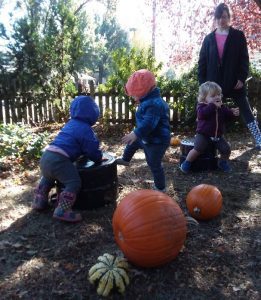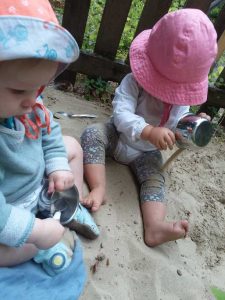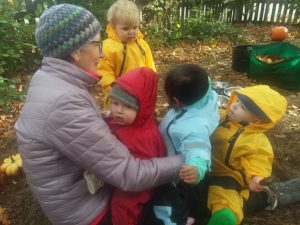 Asked about the principles that guide care for the infants in her home-based program, Chrysalis Family Support and Child Care, Anne-Marie Bley (left) shares:
Asked about the principles that guide care for the infants in her home-based program, Chrysalis Family Support and Child Care, Anne-Marie Bley (left) shares:
Before Chrysalis was an offering, it was a conversation between two friends, a conversation about the qualities of human attachment about the kind of attention and care necessary for human growth. We two friends and colleagues are both retired Waldorf teachers, familiar with RIE (Emmi Pikler and Magda Gerber’s work), and LifeWays’ contribution to the importance of the living arts and a home setting in early childhood care. We also read Antonella Sansons’ book, Working with Parents and Infants, and shared stories from our own biographies.
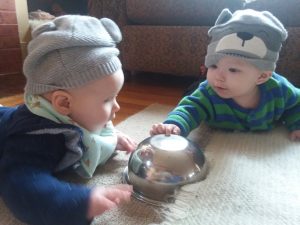 Weaving together our collective experiences and trainings, we researched the qualities necessary for the gestating and newborn infant to embody their physical, emotional and cognitive being. What are the qualities of tending and care that will allow each child to maximize their spiritual gifts? How does the art of care and tending a home life shape the development of the caregiver as well as the care receiver? How do we both learn to love through my attention to your needs and to my own needs throughout the course of a day?
Weaving together our collective experiences and trainings, we researched the qualities necessary for the gestating and newborn infant to embody their physical, emotional and cognitive being. What are the qualities of tending and care that will allow each child to maximize their spiritual gifts? How does the art of care and tending a home life shape the development of the caregiver as well as the care receiver? How do we both learn to love through my attention to your needs and to my own needs throughout the course of a day?
Before Chrysalis was a daycare for infants and toddlers and support for their families, it was a desire and intention to be present and available to those human needs. It was an invitation to learn care skills that have been largely ignored and forgotten in this time in most communities in the United States.
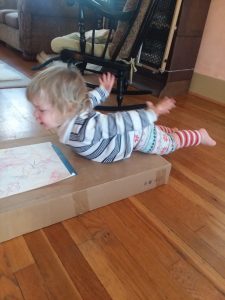 Equal to our desire to hone our caregiving skills, is the intention to allow each child to determine the pace and quality of their own movement. From examples from Emmi Pikler’s life work, I was determined to provide a safe environment for the infants to unfold self-movement when they were in an alert active state. Caregivers—through observation, close-by physical presence and warmth of emotion—companioned the infants as they moved each day. We never placed them in a position they could not achieve by themselves during this active alert time on the floor. Witnessing each child’s unique movement journey and interaction with the force of gravity was nothing less than a holy experience. I believe we were privileged to witness the early manifestations of will in each child. As a result of allowing for self-determined movement in infancy, our children’s physical capabilities as toddlers are well integrated and grounded.
Equal to our desire to hone our caregiving skills, is the intention to allow each child to determine the pace and quality of their own movement. From examples from Emmi Pikler’s life work, I was determined to provide a safe environment for the infants to unfold self-movement when they were in an alert active state. Caregivers—through observation, close-by physical presence and warmth of emotion—companioned the infants as they moved each day. We never placed them in a position they could not achieve by themselves during this active alert time on the floor. Witnessing each child’s unique movement journey and interaction with the force of gravity was nothing less than a holy experience. I believe we were privileged to witness the early manifestations of will in each child. As a result of allowing for self-determined movement in infancy, our children’s physical capabilities as toddlers are well integrated and grounded.
Anne-Marie grew her program organically, gradually increasing the number of infants in her care from one to five, adding one and then another caregiver as needed. She explains:
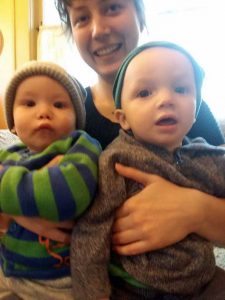 Eventually we had 4 children and 3 coworkers, all working 4 hour shifts (overlapping some) in addition to me caring for a 10-hour day. Caregivers did not have individual children we cared for. I was the primary attachment caregiver and the other caregivers were secondary for the four children we eventually had each day when they were younger than 14-18 months. After that [in September, 2018] we added a 5th child. Lucy was 17 months at the time and is our oldest child by two weeks. Now, at around 2 years old, our children are able to transfer attachment to all caregivers more equally. When I started the hours were 7am – 6pm, Monday – Friday. We now care for the children from 7:30 am to 5pm Monday through Thursday to allow me more personal time.
Eventually we had 4 children and 3 coworkers, all working 4 hour shifts (overlapping some) in addition to me caring for a 10-hour day. Caregivers did not have individual children we cared for. I was the primary attachment caregiver and the other caregivers were secondary for the four children we eventually had each day when they were younger than 14-18 months. After that [in September, 2018] we added a 5th child. Lucy was 17 months at the time and is our oldest child by two weeks. Now, at around 2 years old, our children are able to transfer attachment to all caregivers more equally. When I started the hours were 7am – 6pm, Monday – Friday. We now care for the children from 7:30 am to 5pm Monday through Thursday to allow me more personal time.
I cook and prepare for two snacks and lunch for us all. I hold the rhythm of our days and prepare the home for the rhythm to unfold. As the children become older, more mobile and more verbal, I find more time to witness our time together in addition to giving some direct care to the children.
